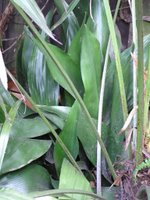
If there's one plant which is synonymous with the Victorian era, then it must be Aspidistra Elatior.
At the height of its popularity, it was said that virtually every house in the land had one of these growing somewhere in a room or hallway.
At the end of the era, the growing of exotic plants including A.Elatior went into a swift decline, to be remembered only in a few books written at the time.
During the 1980's, renewed interest in growing palms and other exotics saw A.Elatior making something of a comeback, this time though, as a garden plant not a house plant.
By coincidence, the late 70's and 80's also saw our old chums the botanists renewing their interest in Aspidistra and this has resulted in many more species being found and described.
So, from the original 8 or 10 species, there are now some 50 plus, with it is believed, yet more to be discovered.
Several of these new discoveries, have been introduced into cultivation and some are proving to be hardy when grown in the garden, A.Elatior however, is still the easiest to find and it's the one I concentrate on in this blog.
Aspidistra are woodland plants originating in the far east.
China it seems, has the most species, with Japan and Vietnam also being home to some fine plants.
At the moment, I only grow A.Elatior and A.e."Variegata", there's also one I've seen called A.e."Milky Way" and this too should make a good garden plant, but I've yet to try it.
A.Elatior, is famed for its ability to grow in less than perfect situations and it certainly does tolerate neglect.
Unfortunately, that's all it does, it tolerate's but it doesn't thrive.
With a modicum of care and attention, you can have a plant that thrive's, prospers and is a credit to your plant growing skills.
Although Aspidistra will grow in deep shade, it seems a shame to plant it where it's likely to go unnoticed.
Far more preferable, is to plant it in light to medium shade in a spot where it can be appreciated.
Avoid planting it in the sun, as this can cause bleaching of the leaves, making them look rather tatty.
Neither A.Elatior or A.e."Variegata" are fussy about soil type, but it must be well drained, dry to moist is preferable, avoid any area with standing water or poor drainage as this is likely to kill your plant. ( As I found to my cost. )
A well cultivated soil is best, dig in plenty of well rotted manure into the planting area and add some fish, blood and bone fertilizer.
The best time for planting out, is early Spring when all danger of frost has gone.
Keep the plant well watered until it's established and then you can leave it to its own devices.
Aspidistra, aren't exactly the greyhounds of the plant world and growth tends to be slow.
Supplementary watering and feeding with weak general purpose fertilizer will speed things up a tad and certainly give you a better looking plant, in fact, a plant to be proud of.
Propagation is by division and this is best done in early Spring.
The process is easy, simply lift the plant and carefully divide it into as many pieces as you need.
Try not to cut tiny bits off, make them a reasonable size.
Remove any excess soil and dead roots, dust all cuts with Sulpher powder.
I pot mine up in a mixture of coir, plenty of Perlite and soilless compost and I add some long life fertilizer pellets.
Keep the pots in a shaded spot until plants are established.
Don't get the compost soaking wet, this is the kiss of death for Aspidiatra, just keep them moist and let them dry out a tad between watering. Posted by: Mike.
Comment: There are some people who find A.Elatior boring.
What poor misguided souls they are, no taste.
I think, it's one of the best plants for the open garden, being easy to grow and maintain.
Add a dash of T.L.C. and you've got a plant that will be the envy of your friends.




